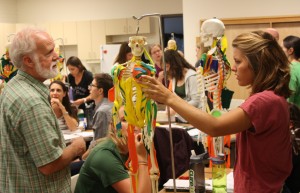 The following column was written by Melissa Wdowik, PhD, RDN, an assistant professor at Colorado State University in the Department of Food Science and Human Nutrition, and director of the Kendall Anderson Nutrition Center.
Genetically engineered foods are all around us: an estimated 60 percent to 80 percent of processed foods in U.S. grocery stores have genetically modified ingredients. With the food labeling initiative Proposition 105 on the November ballot, this is a good time to improve our understanding of both genetic engineering and the voting option before us.
Genetic engineering involves the transfer of genes for particular traits between species. Other terms for genetically engineered (GE) plants (or foods derived from them) are genetically modified (GM), genetically modified organism (GMO), and bioengineered. Historically, most of our foods have been naturally genetically modified through domestication of wild plants and natural selection, and agriculturally modified using genetic and selective breeding. The newer techniques of bioengineering are more precise laboratory methods of physically removing a gene from one organism and adding it into another, giving it the ability to express a desired trait. Most current GM crops have been engineered for resistance to insects, diseases, or herbicides. While “herbicide tolerance” sounds like an excuse to use more herbicides, it actually allows farmers to use products that are more environmentally friendly, while reducing soil erosion and CO2 emissions.
According to Dr. Patrick Byrne, a professor in CSU’s Department of Soil and Crop Sciences, crops most commonly engineered in Colorado include corn, alfalfa, and sugar beets, as well as soybeans and canola. Nationwide, cotton is another major engineered crop.
The biggest concern to consumers is: are these GM crops safe to eat? The term “frankenfood” was coined to reflect fears of unknown changes to our food supply. Indeed there are both pros and cons to genetically engineered foods espoused by supporters and detractors, respectively.
Supporters say benefits include increased pest and disease resistance, drought tolerance, and increased yields. They point to 18 years of GM consumption and hundreds of research studies finding no difference in food safety or nutritional value between GM and non-GM foods. They also point to potential GM crops that are nutritionally superior, such as Golden Rice, enriched with beta-carotene.
Detractors say risks include creation of pesticide-resistant weeds, accidental contamination between GM and non-GM crops and, hypothetically at least, antibiotic resistance and introduction of allergens into foods. The issues go further, however, with political, environmental and industrial arguments beyond the scope of this column. It is a highly complex issue, full of pros and cons.
The question remains, will labeling of GMOs help? Food labeling may give transparency for consumers to make informed decisions, but critics remind us that the cost will be passed on to taxpayers and consumers and loopholes make the benefits questionable: many foods will be exempt even when they do contain GE ingredients. Some experts support labels but want to wait for more accurate, reliable labeling rules. In the meantime, interested consumers can buy certified organic foods, which are by law free of GE ingredients, or “Non-GMO Verified” products. See Dr. Byrne’s thorough, unbiased explanation of labeling pros and cons here.
A related SOURCE story on this ballot measure, "Researcher: Analysis of GMO labeling initiative unbiased," is available here.
The following column was written by Melissa Wdowik, PhD, RDN, an assistant professor at Colorado State University in the Department of Food Science and Human Nutrition, and director of the Kendall Anderson Nutrition Center.
Genetically engineered foods are all around us: an estimated 60 percent to 80 percent of processed foods in U.S. grocery stores have genetically modified ingredients. With the food labeling initiative Proposition 105 on the November ballot, this is a good time to improve our understanding of both genetic engineering and the voting option before us.
Genetic engineering involves the transfer of genes for particular traits between species. Other terms for genetically engineered (GE) plants (or foods derived from them) are genetically modified (GM), genetically modified organism (GMO), and bioengineered. Historically, most of our foods have been naturally genetically modified through domestication of wild plants and natural selection, and agriculturally modified using genetic and selective breeding. The newer techniques of bioengineering are more precise laboratory methods of physically removing a gene from one organism and adding it into another, giving it the ability to express a desired trait. Most current GM crops have been engineered for resistance to insects, diseases, or herbicides. While “herbicide tolerance” sounds like an excuse to use more herbicides, it actually allows farmers to use products that are more environmentally friendly, while reducing soil erosion and CO2 emissions.
According to Dr. Patrick Byrne, a professor in CSU’s Department of Soil and Crop Sciences, crops most commonly engineered in Colorado include corn, alfalfa, and sugar beets, as well as soybeans and canola. Nationwide, cotton is another major engineered crop.
The biggest concern to consumers is: are these GM crops safe to eat? The term “frankenfood” was coined to reflect fears of unknown changes to our food supply. Indeed there are both pros and cons to genetically engineered foods espoused by supporters and detractors, respectively.
Supporters say benefits include increased pest and disease resistance, drought tolerance, and increased yields. They point to 18 years of GM consumption and hundreds of research studies finding no difference in food safety or nutritional value between GM and non-GM foods. They also point to potential GM crops that are nutritionally superior, such as Golden Rice, enriched with beta-carotene.
Detractors say risks include creation of pesticide-resistant weeds, accidental contamination between GM and non-GM crops and, hypothetically at least, antibiotic resistance and introduction of allergens into foods. The issues go further, however, with political, environmental and industrial arguments beyond the scope of this column. It is a highly complex issue, full of pros and cons.
The question remains, will labeling of GMOs help? Food labeling may give transparency for consumers to make informed decisions, but critics remind us that the cost will be passed on to taxpayers and consumers and loopholes make the benefits questionable: many foods will be exempt even when they do contain GE ingredients. Some experts support labels but want to wait for more accurate, reliable labeling rules. In the meantime, interested consumers can buy certified organic foods, which are by law free of GE ingredients, or “Non-GMO Verified” products. See Dr. Byrne’s thorough, unbiased explanation of labeling pros and cons here.
A related SOURCE story on this ballot measure, "Researcher: Analysis of GMO labeling initiative unbiased," is available here.
Read More
 The following column was written by Melissa Wdowik, PhD, RDN, an assistant professor at Colorado State University in the
The following column was written by Melissa Wdowik, PhD, RDN, an assistant professor at Colorado State University in the  An occupational therapy class during the 2014 summer session.[/caption]
Current and former students have voted Colorado State University's
An occupational therapy class during the 2014 summer session.[/caption]
Current and former students have voted Colorado State University's